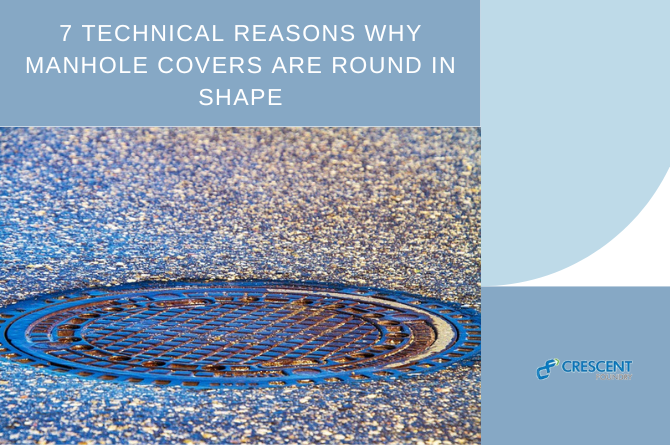Manhole covers, when not selected, installed and maintained in the…

7 Technical Reasons Why Manhole Covers are Round in Shape
When was the last time you came across a manhole cover on the streets, and paused to wonder why it was round in shape? While there is no hard and fast rule regarding what the shape of manhole or sewer covers should be, an overwhelming majority of these covers are round in structure. The top manhole cover manufacturer companies also have circular sewer covers as a key element of their portfolio (rectangular and square manhole covers are also available, but are a lot rarer). We see many manhole covers in a day, nearly all of them are round, and consider them as ‘normal’ – without wondering about why they are engineered in that particular shape.
So, what are the technical reasons behind the creation of round manhole covers? Let’s take a look:
Round Manhole Covers Ensure Easier Mobility
Cast iron manhole covers and sewer covers are typically heavy in structure. As such, mobility should always be an important parameter to consider, while looking for these covers. Smooth movement of manhole covers is also important when they have to be rolled from one place to another – for maintenance and repairs.
Compared to rectangular, triangular or square covers, circular manhole covers can be moved with significantly greater ease. There are very little risks of the covers getting damaged – or safety hazards – during the transportation of these products.
Easy To Manufacture; Easy To Install
As experts from top manhole cover manufacturer companies confirm, round manhole covers are relatively simpler to design, in comparison with covers with corners and edges. The process of pouring the hot metal in the mold becomes easier when the structure of the latter is circular.
The very fact that circular sewer covers do not have any edges or corners also makes sure that they can be installed (i.e., slipped on) efficiently, and without any glitches. There is, generally, no need to line up the covers first (as is required for square/rectangular covers). The installation is straightforward, and the dimensional accuracy of manhole covers designed by leading manufacturers further helps matters. Round manhole covers are also esier to reinstall as it is very important to replace the manhole cover correctly.
Round Covers For Round Manholes
Rotational tools running on power are used to create manholes. These tools typically make round holes. To cover these sewer holes, circular manhole covers are the ideal fit – both in terms of setup ease as well as overall functionality. Using covers of any other shape on round manholes is both problematic as well as sub-optimal from the durability perspective.
Given that the manhole opening is circular, using square or rectangular covers on them poses another potential problem. If they are diagonally rotated, there is every chance of such covers to simply drop into the manhole itself. With round manhole covers, this challenge is eliminated. These circular covers can be rotated as required, without technicians having to worry about them falling right through the opening.
Superior Compression Resistance
There is a wide range of forces and pressures being exerted on the earth’s surface. In order to retain their functionality for a long time, manhole covers need to be able to resist the compressive forces of the earth effectively. Round manhole covers deliver maximum value in this regard. The compression resistance of manhole covers with corners is invariably lower than that of their circular counterparts.
The quality factor of circular sewer covers also warrant a special mention at this point. The top manhole cover manufacturer companies offer cast iron covers that adhere to the latest ASTM and EN-124 parameters. It is always advisable to source manhole covers (circular or otherwise) with all relevant quality certifications (e.g., ISO certifications) – instead of looking for cheaper, sub-standard alternatives.
Easy Portability
Cast iron manhole covers can be as heavy as 135 kgs (or even slightly more). Now imagine trying to move a heavy rectangular cover from one place to another manually. Quite a difficult proposition, right?
As already mentioned earlier, easier portability is one of the most important factors behind the popularity of round-shaped manhole covers. These precision-engineered covers can simply be rolled from the source point to the destination, without too much stress and manual effort. As a result, the lifespan of circular sewer covers tend to be on the higher side.
Economic Factors That Deliver Competitive Advantages
The volume of material required to manufacture a round sewer cover is relatively lesser than what is needed to design covers of other shapes. This is because the surface area of round covers is significantly lower than that of other covers (of similar sizes). Since less of the material is required to manufacture manhole covers of the same strength and durability, the average ROI obtainable from circular manhole covers is higher.
Superior Safety Assurance
From the usability standpoint, round manhole covers offer multiple competitive advantages. For starters, the movement of vehicles becomes a lot safer – since the manhole covers do not have any sharp edges that can damage the tires (i.e., minimal obstructions). In industrial areas, locking these cast iron manhole covers can be done simply by doing a quarter turn. In general too, manhole cover sealing is a lot easier than having to seal covers of other geometrical shapes.
A lot of geometrical calculations and engineering insights go into the finalisation of the shapes of manhole covers. It has been proved beyond reasonable doubt that circular sewer covers offer the maximum strength, resistance and durability – and that’s precisely why every top manhole cover manufacturer focuses on designing round manhole covers, made of best-in-class material and in compliance with all the latest quality parameters. Manhole covers are not round just because that’s the way they are meant to be (or for the generic reason that manholes are also round) – there are important technical reasons behind covers being mostly made in this shape.





